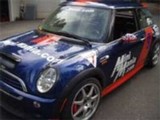Two suspension components have the most direct effect on ride quality and handling performance, the springs and the shocks. The length and resilience of the springs determines how easily and how far the body will move when the wheels hit a bump or when weight is transferred in acceleration, braking, or cornering. The shock absorbers reduce the amount of rebound on the springs, helping the body to return to equilibrium after it bounces.
Let’s start with the springs. Because most car owners put more emphasis on ride comfort than on cornering and acceleration performance, most cars are equipped with fairly soft springs that are designed with a good amount of spring travel. The basis Mini Cooper would be considered in this category.
The Mini Cooper S, with its sport suspension (optional on the Mini Cooper) does use heavier (less-resilient) springs with a bit less travel, but the engineers are still assuming you just want good street handling, and aren’t going to want to go a little fast in the twisty bits or take the car on a track or autocross course.
For these purposes, a stiffer spring and lower ride height will be in order. With a stiffer spring, the car won’t cushion you as much on the bumps, but more important, it won’t sway as much on corners, or shift back and forth as much on acceleration and braking. With a shorter spring, the center of gravity will be a little lower, also reducing the amount of side-to-side or front-to-rear body roll.
Good high-performance spring kits are readily available in the aftermarket. These improved spring kits will help your car maintain its stability when starting, stopping, and turning without wallowing around. These kits won’t make your car ride so rough that your passengers will complain, but they will definitely increase the predictability of the car in the corners and help reduce your lap times. A typical upgraded spring kit sells for less than $250.
While most of the good performance spring kits will work with the original equipment shocks, you might want to consider upgrading your shock absorbers at the same time. The shock absorbers work together with your springs so that the car doesn’t just bounce up and down and up and down every time it sways or hits a bump.
Actually, the term “shock absorber” isn’t quite accurate, since the springs actually absorb the shocks from uneven road surfaces, while the shock absorbers help counter the effect of the springs. The English call them “dampers” which is a more accurate term.
The shock absorbers in the MINI are long tubes that are installed between the wheel and the chassis in parallel with the springs. Inside the outer tube is a piston with a special valve that allows fluid to move from the main tube into the piston as the shock absorber compresses and then move back into the main tube at a slower rate when the shock absorber extends.
The shock absorber works by compressing easily when the spring compresses, but then reducing the rate at which the spring expands. So, instead of continuing to oscillate up and down as it would if only the spring were in between the chassis and wheel, the chassis comes back to a neutral position after only one or two movements.
Like original equipment springs, original equipment shocks are designed to do their job with emphasis on comfort, rather than performance. They damp the spring movement just enough to avoid making passengers seasick, but not enough to give a harder ride. To improve your handling, you’ll want even less oscillation so that the car will return to a neutral position more quickly.
By installing performance shocks, you still get some springing action to absorb the bumps and weight changes, but the car will move less and return to neutral more quickly after acceleration or braking, or in between corners. A set of performance shocks designed specifically for the MINI, such as the one by Koni, is a good complement to shorter, stiffer performance springs. One MINI aftermarket catalog offers the Koni shocks for front and rear for a total of about $690, or the combination of performance springs and Koni shocks for a total of $875.
Spax makes a set of “coil-over” shocks that are an alternative to replacing the springs and shocks separately. With this kit, performance springs are wrapped around the shocks, hence the name, and the combined spring and shock is mounted after removing both the stock spring and stock shock at each corner. This alternative is more expensive that installing springs and shocks separately, typically selling for about $1300.
Coil-over kits can certainly be used to improve the handling on street cars. However, they are more likely to be installed by owners who expect to use their MINI frequently on the track or autocross course, since they are available in different spring rates and do offer the means to adjust ride height at each corner.
Different spring rates will be appropriate, depending on the experience of the driver and the frequency with which the car will be used in competition. Springs that are closer to stock firmness will be appropriate for the person who doesn’t compete too often, and also wants to use the car for street use. On the other hand, if the MINI is only going to be used for competition and the driver is quite experienced, the preference will be for a much firmer spring.
By adjusting the ride height at each corner, the owner can balance corner weights to compensate for other changes that have been made in the car, since balance is very important in tuning the car’s handling for the race track.









